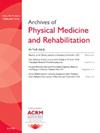术语是否重要?肢体残障人士、临床医生和研究人员的观点。
IF 3.6
2区 医学
Q1 REHABILITATION
Archives of physical medicine and rehabilitation
Pub Date : 2025-01-01
DOI:10.1016/j.apmr.2024.07.019
引用次数: 0
摘要
目的了解肢体残障人士以及医疗保健和/或研究专业人员的首选术语:横断面调查:参与者方便抽样调查:122 人(肢体残障人士 65 人;医疗保健和/或研究专业人员 57 人)完成了在线调查。参与调查的人员必须具备以下条件1)年满 18 周岁;2)自我认定为肢体残障人士(无论病因)或医疗保健或研究专业人士(具有与肢体残障人士打交道的经验);3)在所选角色的大部分时间内居住在美国:不适用 主要结果测量指标:术语的重要性、对 "个人优先 "或 "身份优先 "术语的偏好、首选术语以及个人对术语偏好的看法:大多数参与者为白人(92.6%)。各组之间的年龄存在明显差异(肢体残障人士=49.9 ± 15.4;专业人士=41.0 ± 14.3;P=0.001)。与肢体残障者(约 30%)相比,较少专业人士(5.3%)表示术语对他们来说稍微重要或根本不重要(χ2=16.6,p=0.002)。73.7%的专业人士表示偏好 "以人为本 "的术语,而肢体残障人士的样本则较为平均,42.9%的人表示偏好 "身份第一 "的术语,50.8%的人表示偏好 "以人为本 "的术语。最常选择的肢体和人群术语分别是残肢和个人/肢体残缺者,但许多肢体残缺者表示,在谈论人群时,他们更喜欢 "截肢者":结论:大多数参与者表示术语非常重要或极其重要,两个群体都倾向于使用残肢(肢体术语)和肢体残缺者(人群术语)。然而,本研究并不打算推荐术语,而是帮助人们选择以肢体残缺者为中心的术语。在决定术语时,应考虑到个体性和背景。未来的研究应包括更多来自少数种族/族裔群体的参与者,以及有血管障碍和/或先天性病因的肢体差异患者。本文章由计算机程序翻译,如有差异,请以英文原文为准。
Does Terminology Matter? Perspectives From People With Limb Difference, Clinicians, and Researchers
Objective
To elicit the preferred terminology among people with limb difference as well as health care and/or research professionals.
Design
Cross-sectional survey.
Setting
Online.
Participants
A convenience sample of N=122 individuals (people with limb difference, n=65; health care and/or research professionals, n=57) completed an online survey. People were included if they (1) were aged ≥18 years; (2) self-identified as having limb difference (regardless of etiology) or as a health care or research professional (with experience working with people with limb difference); and (3) lived in the United States for most of the time in their selected role.
Interventions
Not applicable.
Main Outcome Measures
Importance of terminology, preference toward person-first or identity-first terms, preferred terms, and individual perspectives on terminology preferences.
Results
Most participants identified as White (92.6%). Age significantly differed between groups (people with limb difference, 49.9±15.4y; professionals, 41.0±14.3y; P=.001). Approximately 50% of people with limb difference stated terminology was very or extremely important, compared to 70% of professionals (χ2=16.6, P=.002). While 73.7% of professionals reported a preference for person-first terminology, the sample of people with limb difference were more evenly split, as 42.9% reported a preference for identity-first terminology and 50.8% reported a preference for person-first terminology. The most frequently selected limb and population terms, respectively, were residual limb and individual/person with limb difference; however, many people with limb difference indicated they preferred “amputee” when speaking about a population.
Conclusions
Most of the participants indicated terminology was very or extremely important, and both groups tended to prefer the terms residual limb (limb term) and individual/person with limb difference (population term). However, this study was not intended to recommend terminology, but rather help inform terminology choices that are centered around people with limb difference. Individuality and context should be considered when deciding terminology. Future studies should include more participants from racially/ethnically minoritized groups and people with limb difference who have dysvascular and/or congenital etiologies.
求助全文
通过发布文献求助,成功后即可免费获取论文全文。
去求助
来源期刊
CiteScore
6.20
自引率
4.70%
发文量
495
审稿时长
38 days
期刊介绍:
The Archives of Physical Medicine and Rehabilitation publishes original, peer-reviewed research and clinical reports on important trends and developments in physical medicine and rehabilitation and related fields. This international journal brings researchers and clinicians authoritative information on the therapeutic utilization of physical, behavioral and pharmaceutical agents in providing comprehensive care for individuals with chronic illness and disabilities.
Archives began publication in 1920, publishes monthly, and is the official journal of the American Congress of Rehabilitation Medicine. Its papers are cited more often than any other rehabilitation journal.

 求助内容:
求助内容: 应助结果提醒方式:
应助结果提醒方式:


